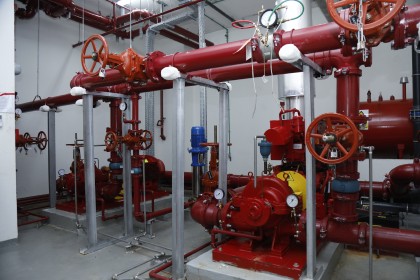 According to the Ministry of Interior, over 2,000 fires were reported across the emirates in the UAE last year. Although most were limited and minor, around 44% were industrial. Most fires break out in Pantry/Commercial kitchen, non-regularized or non-monitored Hot work, and inappropriate electrical equipment.
According to the Ministry of Interior, over 2,000 fires were reported across the emirates in the UAE last year. Although most were limited and minor, around 44% were industrial. Most fires break out in Pantry/Commercial kitchen, non-regularized or non-monitored Hot work, and inappropriate electrical equipment.
Awareness of fire safety regulations and override negligence
Commercial and industrial spaces are subject to different considerations from fires at homes or residential properties and require different types of extinguishers to use on fires burning different types of materials. Where the kitchen is the most common place for fires to start at home, commercial kitchens are also hot spots for fires in industrial facilities, office buildings, and commercial sites. However, fires in industrial environments are typically bigger, more expensive, and result in higher losses of life.
The Major Causes of Fire in Industrial and Commercial Properties
In office buildings and commercial kitchens, the major source of fire is electrical, lighting, and heating equipment. These types of fires can be minimized by using appropriate materials, and installation, following fire safety guidelines regarding overloading electrical circuits, as well as the installation of smoke detectors for early detection. In commercial kitchens, the prevalence of combustible materials increases the risk of the fire spreading, and storage of flammable materials should be exercised with care, especially around open fires and heat sources. In office buildings, flames are typically spread by burning through combustible materials such as office furniture and paper. Although these are not as flammable and don’t burn as hot as some of the liquids found in commercial kitchens, they can result in fires spreading and growing quickly throughout a property.
In industrial sites, combustible dust is the most common way for fires to travel and reach every corner of a facility. Excessively dusty floors can easily catch and spread fire if exposed to a fire source such as cutting torches, welding equipment, and from defective heavy machinery emitting sparks or igniting fuel and lubricants. Flammable liquids and gasses are a common cause of major outbreaks and can cause explosions if they come in contact with a heat source – which is commonly available at industrial facilities.
Safety and Prevention
Fire safety and prevention in industrial sites start with keeping working environments clean and storing flammable liquids and gasses properly and away from heat sources. As with office and commercial buildings, proper fitting and usage of electrical equipment and their regular maintenance are important factors in preventing fires. Passive fire protection starts with smoke detectors, alarm systems, way-finding emergency lights, evacuation maps, and sprinklers. These make up the first line of defense against fires. The use of fire doors is also highly advised, as is the use of non-flammable or fire-retardant materials where possible – especially around mission-critical environments where expensive machinery can be damaged by fire and fire-extinguishing efforts. In addition, active fire protection, which relies on human intervention, requires the availability of fire alarms, blankets, and extinguishers; and is critical for early detection and prevention of the spreading of fires.
Training and education of staff are of vital importance in safeguarding their safety and the facility in case of fire. Relevant personnel needs to know the right protocols to follow in case of fire, and how to assist others as needed. Fire drills should be conducted on a regular basis to ensure that personnel and visitors know how to react in case of fire. In addition, the use of flammable materials and hot-work equipment must only be done by qualified staff. This can be further supported by the reliance on written work orders and supervision by fire safety personnel.
Although not as prevalent, arson is also a cause of fire not to be overlooked. Here, vigilance by staff, housekeeping, and cleaning crews, as well as security personnel play an important role in safeguarding a facility from fires started deliberately.
Classes of Fire and How to Extinguish Them
Fires are classified according to the type of material that is burning, which dictates the different types of fire extinguishers to use on them and is important for making the right type of extinguisher available where it is most relevant.
Class A
A class-A fire is caused by flammable solids such as paper or wood.
The types of extinguishers to use on these fires includes water, foam, ABC dry powder, or wet chemical extinguishers.
Class B
Class B fires are fires burning flammable liquids, such as petrol, cooking oil, and paint.
The types of extinguishers that can be used on these fires are foam, CO2 gas, and ABC dry powder extinguishers.
Class C
Class C fires are flammable gas fires, such as those from propane or butane.
ABC dry powder is the appropriate fire extinguisher to use on Class C fires.
Class D
Class D fires relate to burning flammable metals, such as lithium or magnesium.
These require the use of special dry powder extinguishers.
Class F
Class F fires are burning cooking oils or fat.
Wet chemical fire extinguishers are to be used on these types of fires.
Electrical
Fires involving electrical equipment use a classification of Electrical Fires.
These require the use of CO2 gas or ABC dry powder extinguishers.
Imdaad Group’s Commitment to Fire Safety
In its efforts to safeguard facilities and ensure their safe and smooth operations, Imdaad set up VISION SAFETY LLC in 2007 as a wholly owned subsidiary specializing in the installation and maintenance of fire detection and protection systems in accordance with the UAE Fire & Life Safety Code and NFPA REGULATION. This is supported by regular maintenance that covers all fire detection, fire protection, and gas and water mist systems of any brand and for any type of property.
For industrial and commercial facilities, Vision Safety’s services include the design, supply, installation, testing, commissioning, and certification of fire detection, and fire protection gas and water mist systems. Its services have relied on some of the largest premises in the UAE, including Burj Khalifa, Dubai mall, Dubai Duty-Free, RTA, DEWA, and the Dubai Municipality.
To conduct an assessment of your facility’s fire readiness and compliance with laws and regulations, please contact us.

